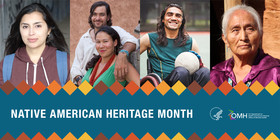 This month, the HHS Office of Minority Health (OMH) celebrates the rich and diverse cultures, traditions, and history and acknowledges the important contributions of American Indians and Alaska Natives (AI/AN) in the United States, including their work in public health. In response to the U.S. Department of Health and Human Services (HHS) Action Plan to Reduce Racial and Ethnic Health Disparities, OMH will focus on promoting promising approaches from federal partners to improve health outcomes in AI/AN populations. According to the Centers for Disease Control and Prevention (CDC), the COVID-19 pandemic has disproportionately affected AI/AN populations across the country. CDC data shows that, compared to non-Hispanic whites, American Indians and Alaska Natives are: - Nearly twice as likely to contract COVID-19
- Over three times as likely to be hospitalized due to COVID-19 infection
- Over twice as likely to die from COVID-19 infection
To help increase confidence in and uptake of COVID-19 vaccines in AI/AN communities, the HHS We Can Do This campaign created a toolkit for tribal leaders that includes information from CDC and new, culturally tailored materials. Additionally, in September, OMH announced the grantees for the Center for Indigenous Innovation and Health Equity. This project aims to support efforts including education, service and policy development, and research related to advancing sustainable solutions to address health disparities and advance health equity among AI/AN and Native Hawaiian and Pacific Islander populations. Visit our Native American Heritage Month website to find information about health disparities, promising approaches downloadable materials, featured blogs, and health resources. | 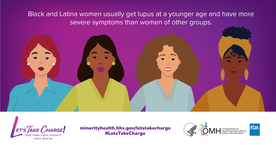 In September, HHS launched a new public education campaign in English and Spanish that aims to increase racial and ethnic minority participation in lupus clinical trials. The Let's Take Charge campaign, developed by OMH and the U.S. Food and Drug Administration's Office of Minority Health and Health Equity (OMHHE), intends to increase diversity in clinical trial participation which helps to ensure that future medical products are safe and effective for everyone living with lupus. Lupus is a chronic and often debilitating autoimmune disease that has a disparate impact on racial and ethnic minorities and diverse populations. Although anyone can get lupus, the disease is more common in women than in men, with nine out of 10 people living with lupus being women. The disease also is more prevalent in people from racial and ethnic minority groups. For more information about the Let's Take Charge campaign, visit minorityhealth.hhs.gov/LetsTakeCharge. Visit the Spanish campaign website ¡Tomemos el control! | 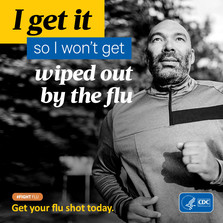 The CDC invites you to encourage everyone six months and older to get a flu vaccine this year with their new 'I Get It' campaign. There are many reasons to get a flu vaccine—whether it is to keep yourself healthy, prevent the worsening of an underlying chronic health condition, protect a loved one who may be more vulnerable to flu's potentially serious complications, or stop the spread of flu in your community. According to the CDC, many of the people who get very sick are older than 65 years or have a medical condition such as diabetes, heart disease, asthma, or kidney disease, or are pregnant. Children younger than 5 years of age are also at greater risk. To fight the flu, it is recommended that you take the following three actions: - Get yourself and your family vaccinated
- Stop the spread by avoiding close contact with people that are sick, covering your coughs and sneezes, and washing your hands often
- Ask your doctor about flu antivirals drugs that can be used to treat flu illness
To protect yourself, your family, and your community from the flu this winter, find a flu clinic near you by visiting the CDC's influenza (flu) webpage, also available in Spanish. | 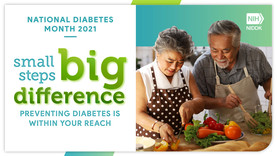 November is National Diabetes Month, a time when communities across the country team up to bring attention to diabetes. Led by the National Institute of Diabetes and Digestive and Kidney Diseases (NIDDK), this year's focus is on prediabetes and preventing diabetes. According to the CDC, approximately 88 million adults in the U.S. —more than 1 in 3—have prediabetes but the majority of people don't know they have it. Prediabetes is a serious health condition where your blood sugar levels are higher than normal, but not high enough yet to be diagnosed as type 2 diabetes. The good news is that by making small healthy lifestyle changes, it is possible to prevent type 2 diabetes and even reverse your prediabetes. To help manage your prediabetes, download NIDDK's Small Steps, Big Difference tip sheet, also available in Spanish. |  On November 18, the National Organization of State Offices of Rural Health (NOSORH) is celebrating National Rural Health Day (NRHD). This day is an opportunity to "Celebrate the Power of Rural" by honoring the selfless, community-minded spirit that prevails in rural America. The observance showcases the efforts of rural healthcare providers, State Offices of Rural Health, and other rural stakeholders to address the unique healthcare challenges that rural citizens face today and into the future. According to NOSORH, an estimated 57 million people – nearly 1 in 5 Americans – live, work and play in rural communities. These communities face a shortage of qualified health care providers in rural and frontier communities. Additionally, rural minorities have even higher rates of poverty and obesity, as well as lower educational attainment, than rural white and urban children. Recognizing and participating in NRHD is one way to demonstrate your commitment to rural health and the "Power of Rural" movement. To support those working to address the unique health challenges facing the rural areas, visit www.powerofrural.org for resources, graphics, tools, and more. | 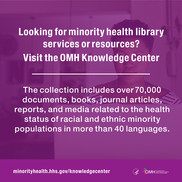 In observance of Native American Heritage Month, the OMH Knowledge Center is featuring a collection of recent reports and articles on health disparities in American Indian/Alaska Native (AIAN) populations. To view this collection in the online catalog, click here. | |

No comments:
Post a Comment